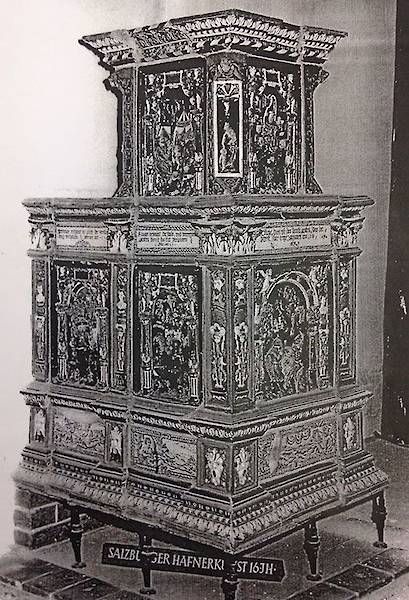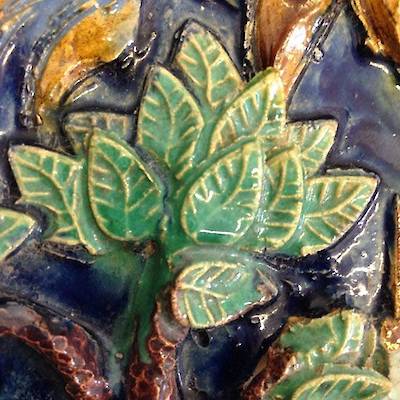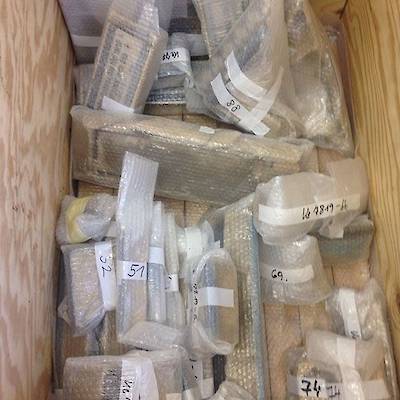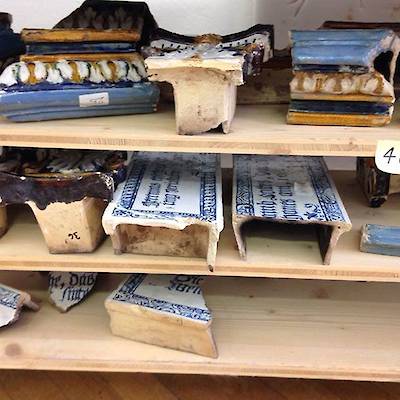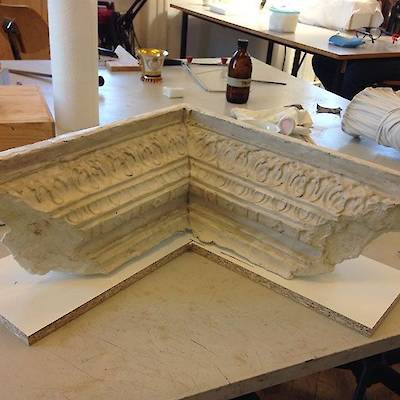The restoration of a tiled stove by Hans Kraut
Marina Parić received her diploma as a restorer from the University of Applied Arts Vienna under several years of supervision by Manfred Trummer, head of the MAK Conservation and Workshops. Still in her studies, the self-employed restorer worked on various projects of the MAK: for example, she worked on the restoration of a Maserati by Franz West, which was poured over with varnish as part of a pouring performance, and on the restoration of a porcelain mantelpiece with metal appliqués designed by Eduard van der Nüll (1860), which is currently on view in the MAK exhibition 300 years of the Vienna Porcelain Manufactory (MAK exhibition hall, 16 May – 23 September 2018). Furthermore, she was involved in the reconstruction of the “Boudoir d'une grande vedette" (1937, design by Josef Hoffmann), displayed at the World Exhibition in Paris, and in various works in the context of the preservation of the collection.
The tiled stove of stove builder Johann Bartholomäus Kraut
“Hans Kraut had gotten to know tiled stoves during his travels as a wandering journeyman in Salzburg, South Tyrol, and Switzerland – which were centers for stove building in the 16th century. He became resident as a master in the then Habsburgic town of Villigen in 1566, where he became one of the leading artists of his guild. Apart from tiled stoves, he also created terracotta mausolea and plaques of honor,” explains Rainald Franz, curator of the MAK Class and Ceramics Collection, about Kraut’s career. In addition to the restauration, Rainald Franz also carries out scientific research on this valuable object of the collection.
The impressive tiled stove was transferred from the Franzenfeste in Laxenburg in 1941. The outside is adorned with blue and white painted tiles and colorfully glazed relief tiles showing religious representations. A model for the figurative execution, Kraut referred to Lukas Cranach’s painting Gesetz und Gnade (Law and Grace, from 1529). To accentuate the scenes, he used valuable gold leaf, and the coloring was done with cold paint.
The restauration of a prime specimen
The stove was permanently installed in the MAK collection until 1990 and had to be dismantled in the course of the installation of a full air conditioning system. It was disassembled into its 97 individual parts and roughly cleaned. The parts were packed an stored in two large transport boxes in the MAK depot. During the dismantling, each piece was marked with a position number and documented both photographically and graphically. The many years of heating and the frequent process of installation and dismantling caused considerable damage to the tiles. Particularly affected were the invisible tiles on the inside of the stove. After thorough cleaning, the flaws were repaired with a special plaster. During the cleaning process, Marina Parić was able to detect a number of older restoration work of varying quality.
Three tiles in the top part are completely missing. In general, there are numerous larger and smaller flaws in almost all of the types of tiles, both in the fragments and in the glaze. Negative molds were produced for the larger additions and formed with a special synthetic mass with additives. The positives obtained in this way were mechanically adjusted to the broken areas of the original parts. Smaller flaws were patched up with the same mass. The additions and repairs made by Marina Parić are important for the sturdiness of the object. They secure the flaws in the glaze and open glazing edges. A number of excellent synthetic materials that prevent the color from changing are available for the glaze supplements, which have also proven to work in the long-term test.
Completion of the restoration process and new installation site
After the three-month restoration is completed, the individual parts of the Renaissance piece are reassembled into two larger units. Due to the age of the stove, it is no longer possible to heat using solid fuels. An electrical heating element with a temperature of 30 to 40 degrees Celsius is installed as the heat source. As a permanent loan from the MAK, the high-quality stove will be shown in an exhibition of the Leogang Mining and Gothic Museum in the context of a Pinzgauer Stube, the historical front room. A contribution by Cäcilia Barani, trainee in the MAK Press and Public Relations Department, and Manfred Trummer, Head of MAK Restoration and Workshops; Original contribution: https://blog.mak.at/restaurierung-kachelofen/
